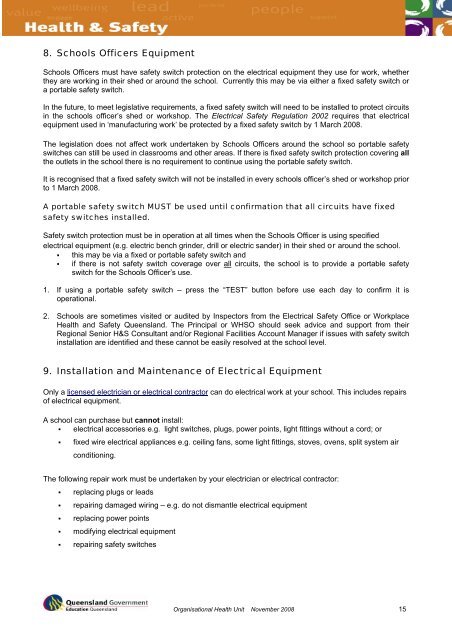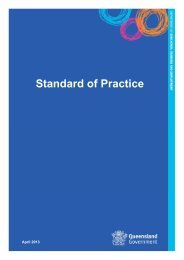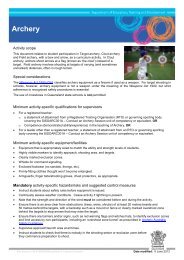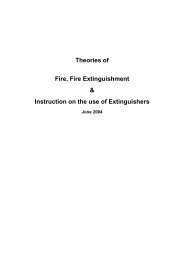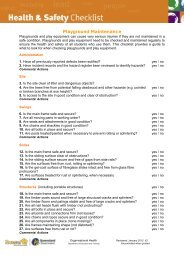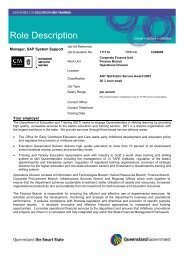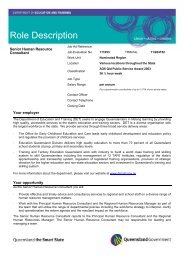1. What must be done to ensure electrical safety in schools? 2 ...
1. What must be done to ensure electrical safety in schools? 2 ...
1. What must be done to ensure electrical safety in schools? 2 ...
You also want an ePaper? Increase the reach of your titles
YUMPU automatically turns print PDFs into web optimized ePapers that Google loves.
8. Schools Officers Equipment<br />
Schools Officers <strong>must</strong> have <strong>safety</strong> switch protection on the <strong>electrical</strong> equipment they use for work, whether<br />
they are work<strong>in</strong>g <strong>in</strong> their shed or around the school. Currently this may <strong>be</strong> via either a fixed <strong>safety</strong> switch or<br />
a portable <strong>safety</strong> switch.<br />
In the future, <strong>to</strong> meet legislative requirements, a fixed <strong>safety</strong> switch will need <strong>to</strong> <strong>be</strong> <strong>in</strong>stalled <strong>to</strong> protect circuits<br />
<strong>in</strong> the <strong>schools</strong> officer’s shed or workshop. The Electrical Safety Regulation 2002 requires that <strong>electrical</strong><br />
equipment used <strong>in</strong> ‘manufactur<strong>in</strong>g work’ <strong>be</strong> protected by a fixed <strong>safety</strong> switch by 1 March 2008.<br />
The legislation does not affect work undertaken by Schools Officers around the school so portable <strong>safety</strong><br />
switches can still <strong>be</strong> used <strong>in</strong> classrooms and other areas. If there is fixed <strong>safety</strong> switch protection cover<strong>in</strong>g all<br />
the outlets <strong>in</strong> the school there is no requirement <strong>to</strong> cont<strong>in</strong>ue us<strong>in</strong>g the portable <strong>safety</strong> switch.<br />
It is recognised that a fixed <strong>safety</strong> switch will not <strong>be</strong> <strong>in</strong>stalled <strong>in</strong> every <strong>schools</strong> officer’s shed or workshop prior<br />
<strong>to</strong> 1 March 2008.<br />
A portable <strong>safety</strong> switch MUST <strong>be</strong> used until confirmation that all circuits have fixed<br />
<strong>safety</strong> switches <strong>in</strong>stalled.<br />
Safety switch protection <strong>must</strong> <strong>be</strong> <strong>in</strong> operation at all times when the Schools Officer is us<strong>in</strong>g specified<br />
<strong>electrical</strong> equipment (e.g. electric <strong>be</strong>nch gr<strong>in</strong>der, drill or electric sander) <strong>in</strong> their shed or around the school.<br />
this may <strong>be</strong> via a fixed or portable <strong>safety</strong> switch and<br />
if there is not <strong>safety</strong> switch coverage over all circuits, the school is <strong>to</strong> provide a portable <strong>safety</strong><br />
switch for the Schools Officer’s use.<br />
<strong>1.</strong> If us<strong>in</strong>g a portable <strong>safety</strong> switch – press the “TEST” but<strong>to</strong>n <strong>be</strong>fore use each day <strong>to</strong> confirm it is<br />
operational.<br />
2. Schools are sometimes visited or audited by Inspec<strong>to</strong>rs from the Electrical Safety Office or Workplace<br />
Health and Safety Queensland. The Pr<strong>in</strong>cipal or WHSO should seek advice and support from their<br />
Regional Senior H&S Consultant and/or Regional Facilities Account Manager if issues with <strong>safety</strong> switch<br />
<strong>in</strong>stallation are identified and these cannot <strong>be</strong> easily resolved at the school level.<br />
9. Installation and Ma<strong>in</strong>tenance of Electrical Equipment<br />
Only a licensed electrician or <strong>electrical</strong> contrac<strong>to</strong>r can do <strong>electrical</strong> work at your school. This <strong>in</strong>cludes repairs<br />
of <strong>electrical</strong> equipment.<br />
A school can purchase but cannot <strong>in</strong>stall:<br />
<strong>electrical</strong> accessories e.g. light switches, plugs, power po<strong>in</strong>ts, light fitt<strong>in</strong>gs without a cord; or<br />
fixed wire <strong>electrical</strong> appliances e.g. ceil<strong>in</strong>g fans, some light fitt<strong>in</strong>gs, s<strong>to</strong>ves, ovens, split system air<br />
condition<strong>in</strong>g.<br />
The follow<strong>in</strong>g repair work <strong>must</strong> <strong>be</strong> undertaken by your electrician or <strong>electrical</strong> contrac<strong>to</strong>r:<br />
replac<strong>in</strong>g plugs or leads<br />
repair<strong>in</strong>g damaged wir<strong>in</strong>g – e.g. do not dismantle <strong>electrical</strong> equipment<br />
replac<strong>in</strong>g power po<strong>in</strong>ts<br />
modify<strong>in</strong>g <strong>electrical</strong> equipment<br />
repair<strong>in</strong>g <strong>safety</strong> switches<br />
Organisational Health Unit Novem<strong>be</strong>r 2008 15


